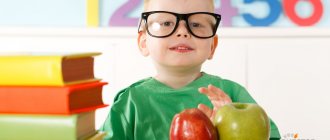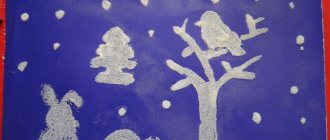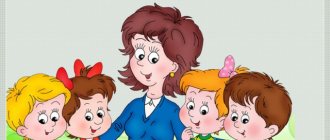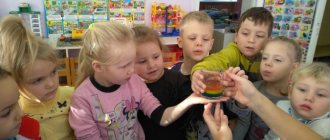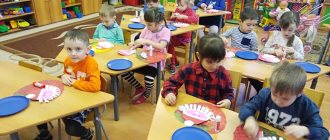Home › Preschool children › Development of creative abilities
Author of the article
Tatyana Stanislavovna Kurtsaeva
Reading time: 5 minutes
AA
Article last updated: 11/10/2019
Cognitive activity is the process of searching and mastering new knowledge and skills. The desire for cognitive and research activity appears already in early childhood, when the child interacts with a variety of objects and phenomena, determines their properties and characteristics, and begins to distinguish between the sensations received from contact with various objects. For older preschoolers, this type of cognitive activity is dominant - children strive to understand how certain things work, learn new things about familiar phenomena and try to organize their knowledge.
Fundamentals of Cognitive Development
One of the most important tasks of teachers and educators is teaching children to navigate large information flows coming from different sources. Moreover, in addition to assimilation and structuring of information, the child must have the ability to search for the necessary data.
Cognitive development includes:
- formation of motivation for knowledge;
- organization of cognitive actions;
- development of creative imagination and activity;
- the formation of self-awareness;
- formation of initial ideas about oneself and other people.
Cognitive development in the younger group
By the age of three, the child remains a full-fledged researcher, his interaction with the outside world is also objective. He perceives reality through things, correlating with them various objects, concepts and phenomena. The principle works: what I see, I explore. However, the help of an adult is necessary so that the baby can reveal all the meanings and possibilities of objects, and not just their external signs. This is how the relationship between external appearance and internal parameters is formed. Causal relationships are determined.
In kindergarten, to develop cognitive activity, it is necessary to conduct excursions at least once a month, to introduce children to the inhabitants of the living area, birds, furnishings, etc.
Interest in research is maintained by making crafts and collecting: leaves, berries, flowers. The cognitive development of three-year-olds is also sensory education: to feel sorry for someone who is upset; cheer up someone who is sad. An important factor is communication - children must be able to talk to each other. They also study themselves - the structure of the body, the rules of caring for it. Skills in caring for animals and flowers are developed. If at this stage a stable interest in research has been formed, then with age it only needs to be maintained, since the child also receives the so-called satisfaction from the discovery, this motivates him to further cognitive activity.
Organization of educational activities
The structure and content of classes are determined in accordance with educational goals and their semantic content. It is recommended to conduct all classes in a playful way with the active use of various gaming techniques.
Lesson structure:
- Introductory stage. Formulating a task for children, or creating a specific game situation.
- Main part. Finding means to solve a problem and achieve a goal. During the lesson, the child gains new experience and knowledge and learns to apply it in various situations.
- The final stage. Children study the results obtained and draw conclusions.
During classes, it is advisable to use interesting didactic material.
Organization of independent activities for children
In the process of independent cognitive activity, children have the opportunity to self-realize and develop creative activity. The child’s ability to work in a group, interact with other children—to cooperate and compete—is formed.
The main methods for developing the desire for knowledge and exploration in preschoolers are:
- information and communication technologies;
- search and research work;
- project work;
- gaming technologies.
Project work
A project is a specific set of actions organized by a teacher or educator and carried out by children. The teacher creates conditions that give children the opportunity, independently or with the help of adults, to gain new practical experience through search and experimentation. Project activities involve the joint work of all participants.
This is an effective teaching technology that forms exploratory thinking, stimulates cognitive activity, and contributes to the development of the child’s communication abilities. Children learn to plan and complete increasingly complex tasks.
Younger preschoolers are actively interested in everything that happens around them. Every day they discover new objects and phenomena, establish relationships between them, their similarities and differences. It is this age period that is characterized by observation, fairly stable attention, development of analytical abilities and readiness for joint activities. The project method involves the use of various research technologies and is perfect for joint activities between a teacher and children.
One of the most important tasks of the teacher when organizing project work is to support the child’s initiative, which always contains a cognitive component.
The project method can be used in classes with children of both junior and senior preschool age. However, the tasks and goals of research activities differ and depend on age.
For children aged 3.5 to 5 years, the imitative-performing method of interaction is better suited when they take part in a project, following the instructions of an adult or imitating him. This method is well suited for young children, as they still have the need to imitate adults.
For children aged 5-6 years, developmental activities are more suitable. At this age, children already know how to interact, coordinate actions and help each other, and are less likely to ask adults for help. Children can independently understand the problem and choose the most appropriate ways to solve it.
Creative activity is most typical for children 6-7 years old. The task of adults in this case is to develop and encourage the creative activity of children. It is also very important to create the necessary conditions for independently searching for a task or problem, the content of the activity, and finding the best ways to work.
No less important for preschoolers are activities such as experiment and research. Here, preschoolers can satisfy their characteristic curiosity, practice identifying cause-and-effect relationships, broaden their horizons, and, accordingly, achieve high intellectual development.
Cognitive development of preschool children
From the experience of a preschool teacher
“The best discovery is the one that a child makes himself” Ralph W. Emerson The Federal Law “On Education in the Russian Federation” states that preschool education should be aimed at the formation of a general culture, the development of physical, intellectual, moral , aesthetic and personal qualities, the formation of prerequisites for educational activities, the preservation and strengthening of the health of preschool children. One of the principles of the Federal State Educational Standards project for preschool education is the formation of cognitive interests and cognitive actions of the child in various types of activities. The educational field “Cognitive Development” involves the development of curiosity and cognitive motivation; formation of cognitive actions, formation of consciousness; development of imagination and creative activity; the formation of primary ideas about oneself, other people, objects of the surrounding world, etc. One of the types of activities to implement the tasks of this area is cognitive research (studying objects of the surrounding world and experimenting with them). In their works, many domestic teachers talk about the need to “include preschoolers in meaningful activities, during which they themselves could discover new things and about the opportunity to acquire knowledge on their own” (G.M. Lyamina, A.P. Usova, E.A. Panko etc.) It has long been no secret that the world opens up to a child through the experience of his personal feelings, actions, and experiences. “The more a child has seen, heard and experienced, the more he knows and has assimilated, the more elements of reality he has in his experience, the more significant and productive, other things being equal, his creative and research activity will be,” wrote the classic of Russian psychological science. science L.S.Vygodsky. Throughout preschool age, along with play activities, cognitive activity is of great importance in the development of the child’s personality, in the process of socialization, which is understood as the process of assimilation of knowledge, skills and abilities, and mainly as the search for knowledge, the acquisition of knowledge independently or tactfully. adult guidance. Cognitive - research activity begins in early childhood. When a child experiments with environmental objects, things, characterizing and highlighting their features. Already by the senior preschool age, cognitive and research activities become one of the leading ones. The child tries to understand how things work, to learn new things about the world and society. Tries to organize his ideas. The cognitive-research activity of an older preschooler manifests itself in the form of so-called children's experimentation with objects, as well as in the form of verbal exploration of questions that a child often asks adults ( why, why, how? ) In the process of learning about the surrounding reality of preschool children, the following stages can be distinguished : The first stage is curiosity. The child explores the surrounding reality with curiosity. A.N. Leontyev noted that a child is born already possessing certain inclinations, with “a readiness to perceive the world” and “the ability to acquire human abilities.” A feature of the second stage of perception of the surrounding world in preschoolers is an increase in its meaningfulness. Children highlight only interesting, significant and unusual objects for them. This promotes the development of curiosity and gives impetus to the emergence of research activities. The importance of the third stage in a preschooler’s knowledge of the world around him is acquired by visual-figurative thinking and imagination. At the fourth stage, the child uses different (acquired) methods of action and begins to focus on the process and the end result. The child develops a forecasting mechanism; he learns to foresee the result of his activities. The next stage of research activity is characterized by the fact that the main motive of reality is cognitive, not practical. The child performs this activity because “it is very interesting” to him. The child’s cognitive orientation allows him to receive various information from the surrounding reality that he encounters at every step. In the future, these skills and abilities acquired by the child in children's games and in specially organized activities are easily instilled and transferred in the future to all types of activities. After all, the most valuable and lasting knowledge is not that which is acquired through learning, but that which is acquired independently. The picture of the world gradually changes in the child’s mind. It becomes more adequate and holistic, reflects the objective properties of things and relationships. Cognitive activity is certainly an active activity in acquiring and using knowledge. It is characterized by the child’s cognitive activity, his active position as a subject of this activity. The motive for cognitive activity in preschool age is determined by the needs of other activities that are significant for the child, primarily play. A component of cognitive activity is cognitive interest—focus on the material (game, environmental, mathematical, etc.). associated with positive emotions. The principle of organizing the cognitive activity of preschool children is the principle of awareness and activity in the process of acquiring knowledge. The main task of a child’s cognitive development is the formation of the need and ability to think and overcome difficulties in solving various problems. Following from the above, this work on cognitive development should be carried out comprehensively. The full cognitive development of preschool children should be organized in three main blocks of the educational process: 1) cognitive classes; 2) in the joint cognitive activity of children with the teacher; 3) in the independent cognitive activity of children. Let us dwell on this in more detail. Organization of cognitive classes The content of cognitive classes depends on the educational program objectives, as well as on the content of the cognitive activity itself. A playful form of educational activities and the active use of gaming techniques during classes are recommended. Organizational structure of a game-based cognitive lesson In the introductory part, a cognitive task is set for children or a cognitive-game problem situation is created (help the hero, sew a dress, organize a trip, etc.). In the main part, the task is solved. In the process of completing a chain of tasks, the child acquires new knowledge and skills (mathematical, constructive), systematizes previously acquired ideas, and learns to apply them to new game problem situations. In the final part, children analyze the results obtained, the course of cognitive activity, and methods of implementation. In the classroom, it is recommended to widely use entertaining didactic material, playing it out in a variety of problem-game situations: didactic games, puzzles, rebuses, riddles, construction sets. The Danish construction set and its Russian analogues provide great opportunities for a child’s cognitive activity. “Dienesh Logic Blocks” are also an effective developmental tool. X. Cuisenaire's colored sticks are actively used in the educational process of modern preschool educational institutions. Organization of joint cognitive activities of the teacher and children. The main forms of organizing children's cognitive activity in this block are didactic and plot-didactic games. Working with children in this form excludes specially organized classes. Children's activity can be caused by the teacher. He involves them in educational and playful activities, showing his own passion for it. Also, the teacher can connect to the children’s already existing activities, directing them from within, as a partner. Alternatively, in some cases, it is possible to build joint cognitive activity so that the child, if desired, can continue it independently. Organization of independent cognitive activity of children Within the framework of this block, the creative activity of children develops in cognitive and play activities, free experimentation with various materials. The child gets the opportunity for self-realization. As part of free independent activity, children master the ability to act in a group, cooperate with friends, and enter into competitive relationships, which are necessary for the child’s prosperous existence in the children’s community. The project method as an option for integrating three blocks of the educational process of a preschool educational institution. To ensure the cognitive activity of children, the project method is widely used. It is used as an option for integrating different types of children's activities. Integration is the interpenetration of program sections and activities into each other, the mutual solution of various problems and educational technologies. The basis of integration is a single problem solved in the topic of the lesson; series of classes; classes; sections of the program. There are many options for working with children. The teacher has the right to choose. The teacher can independently develop and fill each option for organizing the cognitive activity of children of senior preschool age and fill it with content, depending on the characteristics of the educational program. The main thing is to skillfully and effectively use the possibilities of play in the cognitive development of each child. Literature : Federal State Educational Standard, Game education for children 5-7 years old. Methodical recommendations / Ed. N.V. Ivanova. - M.: TC Sfera, 2008. - 112 p., E. Krasheninnikova, Development of cognitive abilities of preschool children, Federal State Educational Standard.-M.: Mosaic - Synthesis, 2014, L.V. Godovkina, Correctional and developmental technologies in preschool educational institutions: programs development of the personal, cognitive sphere, Federal State Educational Standards. – M.: Teacher, 2014.
We recommend watching:
Musical development of preschool children Development of creative abilities of children of senior preschool age Sex education of senior preschool children Development of a sense of rhythm in preschool children
Similar articles:
Children's aggression. What to do?
Independent activity of children in the younger group according to the Federal State Educational Standard during a walk
How to take into account the child’s temperament in the process of teaching activities
Methods for early teaching children mathematics
Maria Montessori's method of early childhood development
Experimentation
It is a form of research activity whose goal is to transform things and processes. Experimentation can be considered as one of the best methods of cognitive activity of preschoolers. Experiments are fun activities that develop curiosity, initiative, creative thinking and independence.
In the process of experimentation, all the child’s senses are involved, which ensures better assimilation, understanding, comprehension and memorization of information. The child’s active participation in the educational process contributes to faster and more intensive development of his cognitive activity and abilities.
Techniques and technologies for cognitive development in kindergarten
The following methods and technologies of cognitive development are used:
- Project activity method. Develops research interest and thinking of a preschooler.
- Experimental research method. Develops activity and independence, the child learns to observe, think, compare, answer questions, draw conclusions, establish a cause-and-effect relationship, and follow safety rules. This includes conversations, observations, modeling, and conducting experiments.
- TRIZ pedagogy. This includes the formation of logical thinking in the child and the development of creative initiative.
- The "magic track" method. The following are set on it: color, shape, size, material, etc., depending on the purpose of the lesson. The hero wanders along this path, transforming in an amazing way.
- The Magic TV method. Consideration of objects and its parts, its connections with the environment.
Theatrical activities in 2 junior groups of preschool educational institutions
Methods are visual, practical and verbal.
Study
The purpose of the study is for the child to master various ways of implementing cognitive initiatives. Children define and solve a problem by searching.
Research activity is natural for a child - he strives for knowledge, takes actions and looks at the result, experiments with objects, studies the causes of phenomena. Search and research activity is the main source of information for a child about the objects around him, therefore the main task of parents, educators and teachers is to help conduct such research. It is very important to help children choose the right object for research and ways to study it, as well as provide assistance in collecting data and presenting results.
One type of experimental activity is experiments - they can be carried out together with a leader or independently. The experiments take place in several stages:
- Determining the goal.
- Selection of means to solve the problem.
- Conducting the experiment.
- Recording observations.
- Formulation of conclusions.
Experiences form the ability to compare, contrast, and identify cause-and-effect relationships. Children learn to draw conclusions, analyze and express conclusions.
Types of activities for cognitive development in preschool educational institutions
The main activity for preschoolers is gaming. With age, games can become more varied and complex. For example, by the age of 3-4 years, cognitive development can occur through construction: arranging cubes in the right order, making a tower and objects out of them, naming materials correctly (cubes, bricks, plates, etc.). The constructor will help you connect objects according to the plot, for example, make a tower out of cubes, and a lawn next to it out of plasticine.
All objects around the child should be bright and attractive, have a clear shape, color and purpose.
Play activities for younger preschoolers are carried out with the help of objects reminiscent of the everyday life of adults: dishes, clothes, toy cleaning devices. Children imitate their parents and learn about the world in this way. Children are given tasks to interact with toys and evaluate them, raising their motivation for new research.
Another type of activity is experimental. It can be developed both in classes in the garden and on walks. For example, a teacher uses a bucket of sand and water to show how to get dirt. An important type of learning about the world is role-playing game for children 5-6 years old. This is recognizing behavior patterns, interacting with each other. Didactic games are welcome, the main goals of which are to achieve perseverance, attention, and consistency of actions from children. In older groups, types of team activities are developed.
Gaming technologies
Gaming technologies are invaluable in stimulating cognitive interest in preschoolers. A game is an emotional activity that can make even very boring information bright and memorable. It activates many mental processes - interest, attention, thinking, perception and memory, and promotes the development of independence and initiative. During the game, children experience interest, joy and a sense of pleasure, which in turn facilitates the process of memorizing and assimilating new information. Games are the leading method for developing children's cognitive activity, so the educational program for preschoolers should be built taking this feature into account.
Lesson on cognitive development in kindergarten
Classes in kindergarten are conducted by teachers, choosing a specific topic, games, and offering children experiments.
Lesson topics
Class topics can be very different, for example:
- "My family".
- “Pedigree is an old Russian tradition.”
- "Introduction to professions."
- "Journey to the city of health."
- "Journey to the village of Prostokvashino." Dedicated to pets.
- “Our kindergarten is so good – you won’t find a better kindergarten.”
- "In a world of kindness."
- “A journey into the world of objects.
- "Transport".
- “How all living things grow.”
Educational games for preschoolers
You can organize the following games with children:
- “Identify by touch.”
- “Name the item by description.”
- “Combine objects by... shape/color/properties.”
- “Where should I put what?”
- "What is in the box?".
- “Name your loved ones.”
- “Say the word.”
- “What a toy.”
- Situational games: “Box of Fairy Tales”, “Anya at the Hairdresser”.
- “You tell me, and we’ll guess.”
- “Imitation game – Washing clothes.”
- Didactic games: “Who needs what for work?”, “Choose the right card,” etc.
Experimentation
Experiments will allow you to simulate the desired experience and introduce children to the properties of objects. These include:
- Planting a plant, caring for it and monitoring it.
- Experiments with sand and its consistency.
- Walking experiments. "What happens if…"
- Experiments with various materials: paints, paper, clay.
- Experiments with instruments: magnifying glass, magnet, scales, etc.
Classes for children with mental retardation
Children with mental retardation require a special approach. The emphasis is on the development of thinking, memory, and perception. Classes are aimed at:
- Activating the interests of a particular child.
- Formation of ideas about space.
- Sensory development.
- Development of associative thinking.
- Teaching techniques of reasoning and inference (through experiments).
- Carrying out mental operations - comparisons, generalizations, classifications.
Theatrical role-playing activities, inclusive games, and conversations are used. A mandatory completion of the lesson will be a “reflection” exercise: the child tells what he liked in the lesson, what was not very comfortable.
Classes for children with visual impairments
If children have visual impairments, then classes will be aimed mainly at developing auditory and tactile perception and fine motor skills of children. These types of activities include:
- Conversations using sensory material.
- Story games.
- Gymnastics, physical minutes.
- Weaving, crafts, modeling.
- Walks, excursions (including tactile ones).
